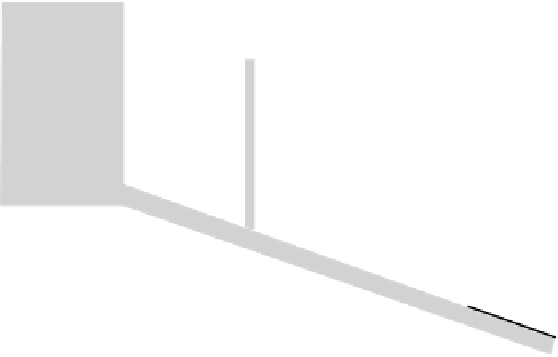Geoscience Reference
In-Depth Information
4.12.5
Deposition from turbidity flows
material into a moving flow. Clearly any extra sediment
added to the flow will cause the head of the flow to accel-
erate. Careful sediment budget studies of Holocene
deposits in the Madeira abyssal plain reveals that 12 percent
or so of turbidite volume is composed of reworked materi-
als. This converts to about an average of 43 mm of erosion
over the total areal extent of an individual deposit.
Deposition from turbidity currents may be due to flow
unsteadiness or to downstream flow nonuniformity. It is
commonly thought that passage of the head is accompa-
nied by erosion. The extent of this is a little known quan-
tity of some importance in calculating the flux of bed
4.13
Flow through porous and granular solids
4.13.1
Flow through stationary porous solids
given by the product of a constant,
g
, times the hydraulic
head,
h
. Thus for practical purposes it suffices to measure
the level,
h
, in stand pipes or wells and then to map the
hydraulic water surface over the area in question (see
Section 6.7.1). The pore water velocity,
u
, is then propor-
tional to the
gradient
,
“Thirsty stones” are disc-shaped surfers cut from highly
porous sandstone which soak up superfluous fluid spilt
from drinks containers. The easy flow of fluid occurs
through what we call generally a
porous medium
. Many
subsurface fluid flows, of water, oil, and gas occur through
such media. In general the pore fluid flow is very slow
(order
, with flow in
the direction of greatest decrease of the field. Note care-
fully that this gradient, called the
hydraulic gradient
, is
not
the same as the gradient of hydrostatic pore pressure
(Fig. 4.68; see also Sections 3.5 and 4.1). In symbols,
u
, of the head field,
10
3
ms
1
) and therefore laminar, so we can
entirely neglect the kinetic contribution to flow energy.
We can also neglect the effects of frictional losses at a con-
stant rate for present purposes. From the Euler-Bernoulli
energy equation (Section 3.12; Cookie 9) we are left with
the total energy available to drive pore water flow as
(
p/
K
, where
K
is the proportionality coefficient
known as the
hydraulic conductivity
. The expression is uni-
versally known as
Darcy's law
, namd after its originator
who was intrigued by the controls of rock hydraulic pressures
on the flow of fountains in Dijon, France in the nineteenth
century. There is some similarity of form of this equation
, termed the
pore water fluid potential
.
From the simple working in Fig. 4.68 we see that
)
z
is
Q
flow in
Piezometer 1
Piezometer 2
∆
h
∆
l
Hydraulic gradient =
∆
h/
∆
l
p
1
z
1
h
2
h
1
p
2
z
2
From the simplified Euler-Bernoulli energy equation
we have, generally:
Q
flow
out
z = 0
Reference datum
Φ
=
g
z
+
p
/
r
Neglecting atmospheric pressure, for piezometer 1,
p
1
=
r
g
(
h
1
-
z
1
) and therefore
Φ
=
g
z
1
+
r
g
(
h
1
-
z
1
)/
r
=
g
h
1
Fig. 4.68
An experiment similar to that conducted by M. Darcy in 1856 to determine the energy relations of flow through porous media.









































Search WWH ::

Custom Search